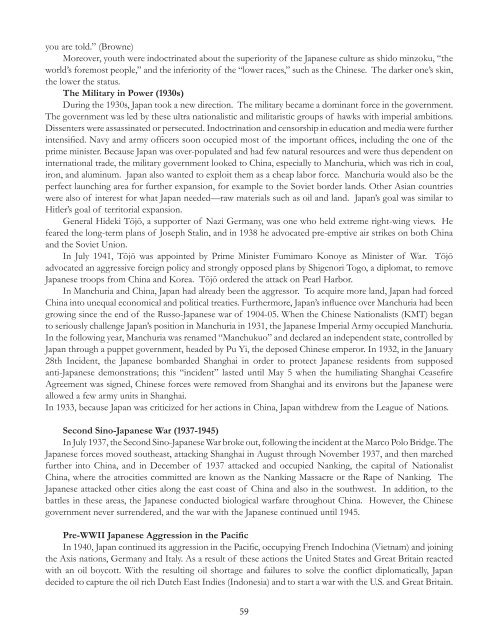Download - Canada ALPHA
Download - Canada ALPHA
Download - Canada ALPHA
Create successful ePaper yourself
Turn your PDF publications into a flip-book with our unique Google optimized e-Paper software.
you are told.” (Browne)<br />
Moreover, youth were indoctrinated about the superiority of the Japanese culture as shido minzoku, “the<br />
world’s foremost people,” and the inferiority of the “lower races,” such as the Chinese. The darker one’s skin,<br />
the lower the status.<br />
The Military in Power (1930s)<br />
During the 1930s, Japan took a new direction. The military became a dominant force in the government.<br />
The government was led by these ultra nationalistic and militaristic groups of hawks with imperial ambitions.<br />
Dissenters were assassinated or persecuted. Indoctrination and censorship in education and media were further<br />
intensifi ed. Navy and army offi cers soon occupied most of the important offi ces, including the one of the<br />
prime minister. Because Japan was over-populated and had few natural resources and were thus dependent on<br />
international trade, the military government looked to China, especially to Manchuria, which was rich in coal,<br />
iron, and aluminum. Japan also wanted to exploit them as a cheap labor force. Manchuria would also be the<br />
perfect launching area for further expansion, for example to the Soviet border lands. Other Asian countries<br />
were also of interest for what Japan needed—raw materials such as oil and land. Japan’s goal was similar to<br />
Hitler’s goal of territorial expansion.<br />
General Hideki Tōjō, a supporter of Nazi Germany, was one who held extreme right-wing views. He<br />
feared the long-term plans of Joseph Stalin, and in 1938 he advocated pre-emptive air strikes on both China<br />
and the Soviet Union.<br />
In July 1941, Tōjō was appointed by Prime Minister Fumimaro Konoye as Minister of War. Tōjō<br />
advocated an aggressive foreign policy and strongly opposed plans by Shigenori Togo, a diplomat, to remove<br />
Japanese troops from China and Korea. Tōjō ordered the attack on Pearl Harbor.<br />
In Manchuria and China, Japan had already been the aggressor. To acquire more land, Japan had forced<br />
China into unequal economical and political treaties. Furthermore, Japan’s infl uence over Manchuria had been<br />
growing since the end of the Russo-Japanese war of 1904-05. When the Chinese Nationalists (KMT) began<br />
to seriously challenge Japan’s position in Manchuria in 1931, the Japanese Imperial Army occupied Manchuria.<br />
In the following year, Manchuria was renamed “Manchukuo” and declared an independent state, controlled by<br />
Japan through a puppet government, headed by Pu Yi, the deposed Chinese emperor. In 1932, in the January<br />
28th Incident, the Japanese bombarded Shanghai in order to protect Japanese residents from supposed<br />
anti-Japanese demonstrations; this “incident” lasted until May 5 when the humiliating Shanghai Ceasefi re<br />
Agreement was signed, Chinese forces were removed from Shanghai and its environs but the Japanese were<br />
allowed a few army units in Shanghai.<br />
In 1933, because Japan was criticized for her actions in China, Japan withdrew from the League of Nations.<br />
Second Sino-Japanese War (1937-1945)<br />
In July 1937, the Second Sino-Japanese War broke out, following the incident at the Marco Polo Bridge. The<br />
Japanese forces moved southeast, attacking Shanghai in August through November 1937, and then marched<br />
further into China, and in December of 1937 attacked and occupied Nanking, the capital of Nationalist<br />
China, where the atrocities committed are known as the Nanking Massacre or the Rape of Nanking. The<br />
Japanese attacked other cities along the east coast of China and also in the southwest. In addition, to the<br />
battles in these areas, the Japanese conducted biological warfare throughout China. However, the Chinese<br />
government never surrendered, and the war with the Japanese continued until 1945.<br />
Pre-WWII Japanese Aggression in the Pacifi c<br />
In 1940, Japan continued its aggression in the Pacifi c, occupying French Indochina (Vietnam) and joining<br />
the Axis nations, Germany and Italy. As a result of these actions the United States and Great Britain reacted<br />
with an oil boycott. With the resulting oil shortage and failures to solve the confl ict diplomatically, Japan<br />
decided to capture the oil rich Dutch East Indies (Indonesia) and to start a war with the U.S. and Great Britain.<br />
59


